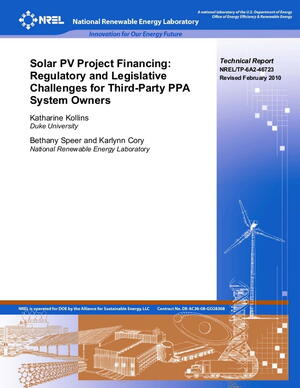
Many end users of electricity would like to use on-site photovoltaic (PV) generation to hedge against volatile electric utility bills and reduce climate change impacts. However, PV systems have high initial costs, and they must be properly operated and maintained to deliver expected benefits.
Providing a potential solution to these cost challenges is a model in which a third-party owner uses a power purchase agreement (PPA) to finance an on-site PV system. This model—the third-party PPA model—allows a developer to build and own a PV system on the customer’s property and sell the power back to the customer. In addition, the third-party PPA model enables the customer to support solar power while avoiding most or all initial costs as well as responsibilities for operations and maintenance, both of which typically transfer to the developer. These advantages appeal to owners of residential and commercial buildings who would like to obtain solar PV systems.
However, third-party electricity sales face regulatory and legislative challenges in some states and jurisdictions. Several of these challenges pertain to whether third-party owners are deemed to act as monopoly utilities, competitive service suppliers (competitive suppliers), or both depending on the degree of retail electricity market deregulation. If third-party owners are deemed to act similarly, according to state definitions or state public utility commission (PUC) definitions, the third-party owners may also need to be regulated by the state PUC. Third-party owners of solar PV systems face an additional challenge if they are not allowed to net meter,1as this is a significant financial incentive to owning these systems.
